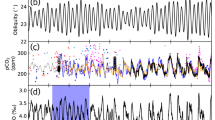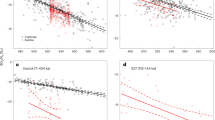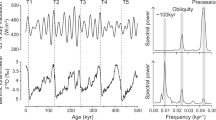Abstract
The 100,000-year timescale in the glacial/interglacial cycles of the late Pleistocene epoch (the past ∼700,000 years) is commonly attributed to control by variations in the Earth's orbit1. This hypothesis has inspired models that depend on the Earth's obliquity (∼ 40,000 yr; ∼40 kyr), orbital eccentricity (∼ 100 kyr) and precessional (∼ 20 kyr) fluctuations2,3,4,5, with the emphasis usually on eccentricity and precessional forcing. According to a contrasting hypothesis, the glacial cycles arise primarily because of random internal climate variability6,7,8. Taking these two perspectives together, there are currently more than thirty different models of the seven late-Pleistocene glacial cycles9. Here we present a statistical test of the orbital forcing hypothesis, focusing on the rapid deglaciation events known as terminations10,11. According to our analysis, the null hypothesis that glacial terminations are independent of obliquity can be rejected at the 5% significance level, whereas the corresponding null hypotheses for eccentricity and precession cannot be rejected. The simplest inference consistent with the test results is that the ice sheets terminated every second or third obliquity cycle at times of high obliquity, similar to the original proposal by Milankovitch12. We also present simple stochastic and deterministic models that describe the timing of the late-Pleistocene glacial terminations purely in terms of obliquity forcing.
This is a preview of subscription content, access via your institution
Access options
Subscribe to this journal
Receive 51 print issues and online access
$199.00 per year
only $3.90 per issue
Buy this article
- Purchase on Springer Link
- Instant access to full article PDF
Prices may be subject to local taxes which are calculated during checkout


Similar content being viewed by others
References
Hays, J., Imbrie, J. & Shackleton, N. Variations in the earth's orbit: Pacemaker of the ice ages. Science 194, 1121–1132 (1976)
Imbrie, J. & Imbrie, J. Modeling the climatic response to orbital variations. Science 207, 943–953 (1980)
Paillard, D. The timing of Pleistocene glaciations from a simple multiple-state climate model. Nature 391, 378–391 (1998)
Liu, H. Insolation changes caused by combination of amplitude and frequency modulation of the obliquity. J. Geophys. Res. 104, 25197–25206 (1999)
Gildor, H. & Tziperman, E. Sea ice as the glacial cycles' climate switch: Role of seasonal and orbital forcing. Paleoceanography 15, 605–615 (2000)
Saltzman, B. Stochastically-driven climatic fluctuations in the sea-ice, ocean temperature, CO2, feedback system. Tellus 34, 97–112 (1982)
Pelletier, J. Coherence resonance and ice ages. J. Geophys. Res. 108, doi:10.1029/2002JD003120 (2003)
Wunsch, C. The spectral description of climate change including the 100ky energy. Clim. Dyn. 20, 353–363 (2003)
Saltzman, B. Dynamical Paleoclimatology: Generalised Theory of Global Climate Change (Academic, San Diego, 2002)
Broecker, W. Terminations. in Milankovitch and Climate (eds Berger, A. et al.) Part 2, 687–698 (D. Riedel, Hingham, 1984)
Raymo, M. E. The timing of major climate terminations. Paleoceanography 12, 577–585 (1997)
Milankovitch, M. Kanon der Erdbestrahlung und seine Andwendung auf das Eiszeiten-problem (Royal Serbian Academy, Belgrade, 1941)
Huybers, P. & Wunsch, C. A depth-derived Pleistocene age-model: Uncertainty estimates, sedimentation variability, and nonlinear climate change. Paleoceanography 19, doi:10.1029/2002PA000857 (2004)
Imbrie, J. et al. in Milankovitch and Climate (eds Berger, A. et al.) Part 1, 269–305 (D. Riedel Publishing Company, 1984)
Shackleton, N. J., Berger, A. & Peltier, W. R. An alternative astronomical calibration of the lower Pleistocene timescale based on ODP site 677. Trans. R. Soc. Edinb. Earth Sci. 81, 251–261 (1990)
Roe, G. & Allen, M. A comparison of competing explanations for the 100,000-yr ice age cycle. Geophys. Res. Lett. 26, 2259–2262 (1999)
Blunier, T. & Brook, E. Timing of millennial-scale climate change in Antarctica and Greenland during the last glacial period. Science 291, 109–112 (2001)
Wunsch, C. Greenland-Antarctic phase relations and millennial time-scale climate fluctuations in the Greenland cores. Quat. Sci. Rev. 22, 1631–1646 (2003)
Marshall, S. & Clark, P. Basal temperature evolution of North American ice sheets and implications for the 100-kyr cycle. Geophys. Res. Lett. 29, doi:10.1029/2002GL015192 (2002)
Zwally, H. et al. Surface melt-induced acceleration of greenland ice-sheet flow. Science 297, 218–222 (2002)
Rubincam, D. Insolation in terms of earth's orbital parameters. Theor. Appl. Climatol. 48, 195–202 (1994)
Huybers, P. & Wunsch, C. Rectification and precession-period signals in the climate system. Geophys. Res. Lett. 30, doi:10.1029/2003GL017875 (2003)
Raymo, M. & Nisancioglu, K. The 41 kyr world: Milankovitch's other unsolved mystery. Paleoceanography 18, doi:10.1029/2002PA000791 (2003)
Berger, A. & Loutre, M. F. Astronomical solutions for paleoclimate studies over the last 3 million years. Earth Planet. Sci. Lett. 111, 369–382 (1992)
Huybers, P. On the Origins of the Ice Ages: Insolation Forcing, Age Models, and Nonlinear Climate Change. PhD thesis, MIT (2004)
Wunsch, C. Quantitative estimate of the Milankovitch-forced contribution to observed quaternary climate change. Quat. Sci. Rev. 23, 1001–1012 (2004)
Ruddiman, W. F. Oribital insolation, ice volume, and greenhouse gases. Quat. Sci. Rev. 22, 1597–1622 (2003)
Upton, G. & Fingleton, B. Spatial Data Analysis by Example Vol. 2 (John Wiley and Sons, Chichester, 1989)
Rosenblum, M. & Pikovsky, A. Synchronization: from pendulum clocks to chaotic lasers and chemical oscillators. Contemp. Phys. 44, 401–416 (2003)
Schreiber, T. & Schmitz, A. Surrogate time series. Physica D 142, 346–382 (2000)
Acknowledgements
Useful comments were provided by E. Boyle, W. Curry, T. Herbert, J. McManus, F. Ng, M. Tingley and G. Yang. P.H. is supported by the NOAA Postdoctoral Program in Climate and Global Change and C.W. is supported in part by the National Ocean Partnership Program (ECCO).
Author information
Authors and Affiliations
Corresponding author
Ethics declarations
Competing interests
The authors declare that they have no competing financial interests.
Supplementary information
Supplementary Tables S1 and S2
This file contains data and statistics pertinent to testing the hypotheses of orbital control of the late Pleistocene glacial cycles. (PDF 18 kb)
Rights and permissions
About this article
Cite this article
Huybers, P., Wunsch, C. Obliquity pacing of the late Pleistocene glacial terminations. Nature 434, 491–494 (2005). https://doi.org/10.1038/nature03401
Received:
Accepted:
Issue Date:
DOI: https://doi.org/10.1038/nature03401
Comments
By submitting a comment you agree to abide by our Terms and Community Guidelines. If you find something abusive or that does not comply with our terms or guidelines please flag it as inappropriate.



